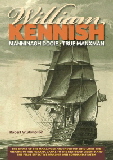On the 10th of January 1844 the Manx newspaper Mona’s Herald published William Kennish’s poem “Elegy on an ancient burying ground, bearing no trace of its origin. situate near the source of the river Cornaa, Isle of Man”.
The newspaper editor added the introductory compliment “from a beautiful volume of poems just published, entitled Mona’s Isle and other poems, by William Kennish, R.N. The following elegy contains poetry of a high order.”
The burial ground William wrote about here is very likely to be Keeill Woirrey – St Mary’s Chapel, about one mile below the source of the Cornaa River on Clagh Ouyr and a mile and a half west of his birthplace. Close by the Keeill is Cornaa farm-house, where William’s father farmed and which was most likely William’s childhood home. Directly opposite the farm-house on the other side of the Cornaa valley is an overgrown hut circle which may have been an alternative focus of William’s attention.
The Mona’s Herald later published a lengthy extract taken from Mona’s Isle Canto II, which the editor entitled “Boggane Gob Na Scoote, A Manx Legend” and this comprised thirty verses starting with
Full many a tale was told in days of yore
Of this alarming phantom of the night,
‘Twas said to be a man besmear’d in gore,
With countenance terrific to the sight. …
(The full text of this poem can be found in the later pages of Mona’s Isle, which have been reproduced in the book) This was followed on April 13th 1844 by a brief report in the newspaper Manx Sun welcoming William back to the Isle of Man “after an absence above a score of years”. The editor complimented him on the vividness of his poetry and noted that there had been substantial improvements to the island since his initial departure.
Mona’s Isle contains a further wide selection of poetry - called by AW Moore, the Manx Historian as “crude Manx” which can also be viewed at A Manx Notebook.

Site Copyright Statement © 2011-2022 Robert W Stimpson
